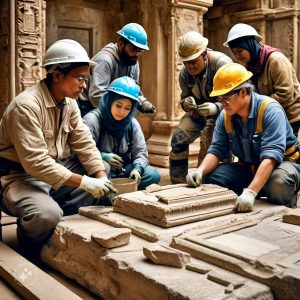Introduction
Cultural heritage sites are the living testament of a community’s history, traditions, and values. These sites, whether they are ancient temples, historic buildings, or sacred landmarks, hold invaluable significance to the people who identify with them. They not only offer a glimpse into the past but also serve as educational, cultural, and economic resources for future generations.
However, these sites are vulnerable to various threats, including environmental degradation, urban development, and political conflict. The preservation of cultural heritage sites is crucial for maintaining our shared human history and ensuring that future generations have access to the same knowledge and insights.
In this article, we will delve into the importance of preserving cultural heritage sites, the challenges they face, and the global efforts to safeguard them.
The Importance of Cultural Heritage Sites
Cultural heritage sites represent the historical identity of a society, encapsulating the artistry, knowledge, and way of life of past civilizations. These sites provide both cultural and economic benefits:
- Cultural Significance:
Cultural heritage sites are windows into the past, helping us understand the evolution of societies. They contain invaluable knowledge about art, religion, politics, and technological advancements. For example, the pyramids in Egypt or the temples of Angkor Wat offer profound insights into ancient civilizations, their beliefs, and their achievements. - Educational Value:
Heritage sites serve as educational tools, where people from all over the world come to learn about history, architecture, and diverse cultural practices. They foster global understanding and intercultural dialogue, bridging differences between communities and creating connections based on shared history. - Tourism and Economy:
Many countries rely on cultural heritage sites as major tourist attractions, contributing to their economy. Landmarks like the Colosseum in Rome or Machu Picchu in Peru draw millions of visitors each year, generating revenue through tourism that supports local communities.
Challenges Facing Cultural Heritage Sites
Despite their importance, cultural heritage sites face numerous threats that jeopardize their preservation:
- Environmental Degradation:
Climate change, pollution, and natural disasters pose severe risks to many heritage sites. Rising sea levels, for instance, threaten coastal heritage sites such as Venice, Italy, while earthquakes have caused irreparable damage to sites like the Kathmandu Valley in Nepal.

- Urbanization and Development:
As cities expand and populations grow, many heritage sites are endangered by urban development. Construction projects may encroach on historic lands, and new buildings can overshadow the aesthetic and historical significance of heritage sites. The need for modern infrastructure can often lead to the destruction or modification of heritage buildings, disrupting their original essence. - Neglect and Lack of Funding:
Preserving heritage sites requires significant financial investment. In many cases, governments and local authorities lack the resources needed to maintain these sites. As a result, many structures fall into disrepair, with few restoration efforts in place. This issue is particularly prevalent in developing countries, where funding for cultural preservation may be limited. - Conflict and Vandalism:
War, political conflict, and deliberate acts of vandalism are some of the most destructive forces facing cultural heritage sites today. In recent years, conflicts in countries like Syria, Iraq, and Yemen have resulted in the tragic loss of ancient landmarks. Terrorist organizations and militant groups have deliberately targeted cultural symbols in acts of erasure, removing traces of civilizations that once flourished in these regions.
Global Efforts to Preserve Cultural Heritage
International organizations, governments, and local communities play a key role in the preservation of cultural heritage. Several initiatives have been established to ensure the protection and maintenance of these invaluable sites:
- UNESCO’s World Heritage Program:
The United Nations Educational, Scientific and Cultural Organization (UNESCO) has long been at the forefront of global heritage preservation. Its World Heritage Program identifies and inscribes culturally significant sites around the world, affording them international recognition and protection. UNESCO works with governments and local authorities to manage and preserve these sites, ensuring that they remain intact for future generations. - Cultural Preservation Through Technology:
Advances in technology have revolutionized heritage preservation efforts. Digital mapping, 3D scanning, and artificial intelligence (AI) have made it easier to document, restore, and manage cultural sites. For example, 3D scanning technology was used to restore the Great Buddha of Bamiyan in Afghanistan after it was destroyed by the Taliban in 2001.

- International Collaboration:
The preservation of cultural heritage sites often requires collaborative efforts between governments, non-governmental organizations (NGOs), and international bodies. Organizations like the World Monuments Fund (WMF) and the International Council on Monuments and Sites (ICOMOS) work with local authorities to preserve and restore heritage sites. These groups often provide funding, expertise, and resources to protect sites at risk. - Public Awareness Campaigns:
Public awareness campaigns are crucial in fostering a sense of collective responsibility toward preserving heritage sites. Educational programs, media campaigns, and heritage tours help raise awareness about the importance of protecting these cultural treasures. Public involvement in heritage preservation not only generates interest but also encourages local communities to take ownership of their heritage.
Case Studies: Successful Preservation Projects
- The Great Wall of China:
The Great Wall, one of the most iconic heritage sites in the world, faced significant erosion and damage over time. Restoration efforts led by the Chinese government, in collaboration with UNESCO, have been crucial in preserving this ancient structure. Today, large sections of the Wall have been restored, while efforts continue to prevent further degradation. - The Colosseum, Rome:
Rome’s Colosseum, another major heritage site, has undergone extensive preservation efforts. The Italian government, together with international organizations, has worked to protect the structure from pollution, weathering, and vandalism. Conservationists have focused on restoring sections of the amphitheater while keeping its historical authenticity intact. - Angkor Wat, Cambodia:
The temple complex of Angkor Wat in Cambodia, one of the largest religious monuments in the world, has been the focus of major restoration efforts. Initiatives by UNESCO and various international teams have helped to preserve the intricate carvings and architecture, which were at risk due to natural erosion and vegetation growth. The site remains a key part of Cambodia’s cultural and religious identity.
Conclusion
Preserving cultural heritage sites is vital for maintaining our connection to history and culture. These landmarks are more than just physical structures; they are embodiments of human achievement, artistic expression, and shared experiences. By protecting them, we ensure that future generations can learn from and be inspired by our past.
However, safeguarding these sites requires global collaboration, financial investment, and technological innovation. While challenges remain, the continued efforts of international organizations, governments, and communities give hope that we can preserve these irreplaceable treasures.


